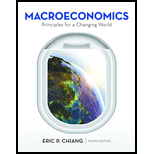
The
Explanation of Solution
The difference between the values of export and import of a nation in a given period is known as the balance of trade or the net export. Balance of trade is an important component of the balance of payment of a country. The occurrence of deficit or surplus in the balance of payment depends upon the balance of trade. If the total value of export of a country is less than its imports, then there is a trade deficit. There are several factors that affect the trade deficit, such as value of currency, taste and preference of the consumers, money supply in the domestic economy,
Balance of trade: Balance of trade refers to the difference between the values of a country’s export and import.
Trade deficit: Trade deficit means that the value of import of a country is greater than the value of its export.
Want to see more full solutions like this?
Chapter 16 Solutions
Macroeconomics: Principles for a Changing World
- Suppose the government imposes a fuel levy, identify, and discuss at least two ways in which this increase might have an effect on GDP growth, making use of the assumptions of the Keynesian model of income and expenditure.arrow_forwardCan you please assist Suppose the Government of Botswana has decided to implement a national minimum wage, but they have not yet decided at which rate to set this wage. With the aid of two separate diagrams, discuss the possible implications of setting this rate (i) at and (ii) below the equilibrium wage rate, respectively.arrow_forwardIf interest rate parity holds between two countries, then it must be true that: Question 3 options: The interest rates between the two countries are equal. The current forward rate is an unbiased predictor of the future exchange rate. The interest rate differential between the two countries is equal to the percentage difference between the forward exchange rate and the spot exchange rate. Significant covered interest arbitrage opportunities exist between the two currencies. The exchange rate adjusts to keep purchasing power constant across the two currencies.arrow_forward
- If interest rate parity holds between two countries, then it must be true that: Question 3 options: The interest rates between the two countries are equal. The current forward rate is an unbiased predictor of the future exchange rate. The interest rate differential between the two countries is equal to the percentage difference between the forward exchange rate and the spot exchange rate. Significant covered interest arbitrage opportunities exist between the two currencies. The exchange rate adjusts to keep purchasing power constant across the two currencies.arrow_forwardSuppose the indirect exchange rate for the Canadian dollar is 0.93. Based on this, you know you can buy: Question 2 options: $1 U.S. for $1.93 Canadian. $1 U.S. for $1.08 Canadian. $1 U.S. for $0.93 Canadian. $1.93 U.S. for $1 Canadian. $1.08 U.S. for $1 Canadian.arrow_forwardAccording to the relative purchasing power parity theory, high inflation in country A and low inflation in country B will cause the value of country A's currency to appreciate relative to that of country B. Question 1 options: True Falsearrow_forward
- How might different tax structures influence consumer behavior in luxury versus essential goods?arrow_forwardWhat is a competitive market?arrow_forwardلا. Assignniend abcpain the the three type of state- and explaining of the decannolly you know + 29 Explain Cu Marginal utility Jaw State the lid of diminishing. Explain the Concept of the aid of ha the relations and marginal uitity. Marginal finishing حومarrow_forward
- How does the change in consumer and producer surplus compare with the tax revenue?arrow_forwardConsidering the following supply and demand equations: Qs=3P-1 Qd=-2P+9 dPdt=0.5(Qd-Qs) Find the expressions: P(t), Qs(t) and Qd(t). When P(0)=1, is the system stable or unstable? If the constant for the change of excess of demand changes to 0.6, this is: dPdt=0.6(Qd-Qs) do P(t), Qs(t) and Qd(t) remain the same when P(0)=1?arrow_forwardConsider the following supply and demand schedule of wooden tables.a. Draw the corresponding graphs for supply and demand. b. Using the data, obtain the corresponding supply and demand functions. c. Find the market-clearing price and quantity. Price (Thousands USD) Supply Demand2 96 1104 196 1906 296 270 8 396 35010 496 43012 596 51014 696 59016 796 67018 896 75020 996 830arrow_forward

 Principles of Economics (12th Edition)EconomicsISBN:9780134078779Author:Karl E. Case, Ray C. Fair, Sharon E. OsterPublisher:PEARSON
Principles of Economics (12th Edition)EconomicsISBN:9780134078779Author:Karl E. Case, Ray C. Fair, Sharon E. OsterPublisher:PEARSON Engineering Economy (17th Edition)EconomicsISBN:9780134870069Author:William G. Sullivan, Elin M. Wicks, C. Patrick KoellingPublisher:PEARSON
Engineering Economy (17th Edition)EconomicsISBN:9780134870069Author:William G. Sullivan, Elin M. Wicks, C. Patrick KoellingPublisher:PEARSON Principles of Economics (MindTap Course List)EconomicsISBN:9781305585126Author:N. Gregory MankiwPublisher:Cengage Learning
Principles of Economics (MindTap Course List)EconomicsISBN:9781305585126Author:N. Gregory MankiwPublisher:Cengage Learning Managerial Economics: A Problem Solving ApproachEconomicsISBN:9781337106665Author:Luke M. Froeb, Brian T. McCann, Michael R. Ward, Mike ShorPublisher:Cengage Learning
Managerial Economics: A Problem Solving ApproachEconomicsISBN:9781337106665Author:Luke M. Froeb, Brian T. McCann, Michael R. Ward, Mike ShorPublisher:Cengage Learning Managerial Economics & Business Strategy (Mcgraw-...EconomicsISBN:9781259290619Author:Michael Baye, Jeff PrincePublisher:McGraw-Hill Education
Managerial Economics & Business Strategy (Mcgraw-...EconomicsISBN:9781259290619Author:Michael Baye, Jeff PrincePublisher:McGraw-Hill Education





